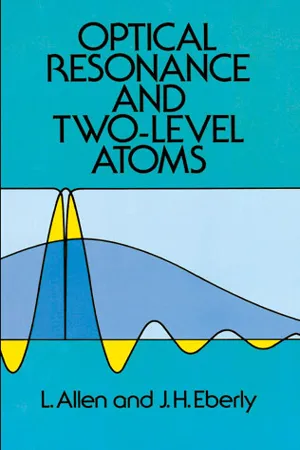
Optical Resonance and Two-Level Atoms
L. Allen, J. H. Eberly
- 256 Seiten
- English
- ePUB (handyfreundlich)
- Über iOS und Android verfügbar
Optical Resonance and Two-Level Atoms
L. Allen, J. H. Eberly
Über dieses Buch
`Coherent and lucid…a valuable summary of a subject to which [the authors] have made significant contributions by their own research.` — Contemporary Physics
Offering an admirably clear account of the basic principles behind all quantum optical resonance phenomena, and hailed as a valuable contribution to the literature of nonlinear optics, this distinguished work provides graduate students and research physicists probing fields such as laser physics, quantum optics, nonlinear optics, quantum electronics, and resonance optics an ideal introduction to the study of the interaction of electromagnetic radiation with matter.
The book first examines the applicability of the two-level model for atoms to real atoms, then explores semiclassical radiation theory, and derives the optical Bloch equations. It then examines Rabi inversion, optical nutation, free-induction decay, coherent optical transient effects, light amplification, superradiance, and photon echoes in solids and gases.
Before the publication of this book, much of the material discussed was widely scattered in other books and research journals. This comprehensive treatment brings it together in one convenient resource. The style of writing is clear and informal and the emphasis throughout is always on the physics of the processes taking place. There are numerous helpful illustrations, excellent introductions to each chapter, and lists of references for further reading.
`The authors have endeavored to create a primer for the field of optical resonance…they have succeeded admirably. Their coverage of the subject is remarkably complete.` — IEEE Journal of Quantum Electronics
Häufig gestellte Fragen
Information
CHAPTER 1
Classical Theory of Resonance Optics
1.1 INTRODUCTION
1.2 THE LINEAR DIPOLE OSCILLATOR
Inhaltsverzeichnis
- DOVER BOOKS ON PHYSICS
- Title Page
- Copyright Page
- Dedication
- Preface
- Related Books and Reviews
- Table of Contents
- CHAPTER 1 - Classical Theory of Resonance Optics
- CHAPTER 2 - The Optical Bloch Equation
- CHAPTER 3 - Two-Level Atoms in Steady Fields
- CHAPTER 4 - Pulse Propagation
- CHAPTER 5 - Pulse Propagation Experiments
- CHAPTER 6 - Saturation Phenomena
- CHAPTER 7 - Quantum Electrodynamics and Spontaneous Emission
- CHAPTER 8 - N-Atom Spontaneous Emission and Superradiant Decay
- CHAPTER 9 - Photon Echoes
- Index